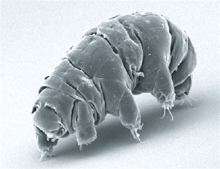Milnesium tardigradum
| Milnesium tardigradum | |
|---|---|
 | |
| SEM image of Milnesium tardigradum | |
| Scientific classification | |
| Kingdom: | Animalia |
| Phylum: | Tardigrada |
| Class: | Eutardigrada |
| Order: | Apochela |
| Family: | Milnesiidae |
| Genus: | Milnesium |
| Species: | M. tardigradum |
| Binomial name | |
| Milnesium tardigradum Doyère, 1840 | |
Milnesium tardigradum is a cosmopolitan species of tardigrades that can be found in a diverse range of environments.[1] M. tardigradum has also been found in the sea around Antarctica.[2] M. tardigradum was described by Doyère in 1840.[3][4] M. tardigradum contains unidentified osmolytes which could potentially provide important information in the process of cryptobiosis.[5]
Description
Morphology
M. tardigradum has a symmetrical body with a total of eight legs. The M. tardigradum utilize claws, a distinctive feature for this tardigrade species. The total length of the body varies, with some measuring up to 0.7 millimeters in length.[6]
M. tardigradum has been found to have a high level of radioresistance.[7] In 2007, individuals of two tardigrade species, Richtersius coronifer and M. tardigradum, were subject to the radiation, near-vacuum and near-absolute zero conditions of outer space as part of the European Space Agency's Biopan-6 experiment. Three specimens of M. tardigradum survived.[8] The M. tardigradum is able to cope with high amounts of environmental stress by initiating cryptobiosis. It is found that during this state, the internal organic clock of the M. tardigradum halts, thus the cryptobiotic state does not contribute to the aging process.[9]
Nutrition
M. tardigradum is an omnivorous predator. It typically feeds on other small organisms such as algae, rotifers, and nematodes. There have also been recorded cases of M. tardigradum feeding on other smaller tardigrades.[10]
Evolution
M. tardigradum has been phylogenetically linked to arthropods. Although the extent of the relationship is still debated, there is evidence that tardigrades and arthropods have a close evolutionary history.[9]
Habitat
The biogeographical distribution of M. tardigradum is large. The species occupies mostly aquatic environments such as marine, coastal and terrestrial areas. The exact distribution of M. tardigradum is difficult to analyze due to the difficulty in taxonomy and the lack of sufficient data.[9]
Reproduction and development
M. tardigradum reproduces both sexually and through parthenogenesis. The exact mating behavior of tardigrades is difficult to reproduce under artificial conditions, hence the frequency and time of reproduction is not fully understood. It is unknown if and when there is a mating season for M. tardigradum.[11]
Females lay up to twelve eggs which hatch after several days (around five to sixteen days). The development of the newly hatched larvae is marked by various molting stages, rather than metamorphosis. The time frame of these molting stages vary from each tardigrade as it is dependent on the nutrition of the specific individual.[12] Once the molting stages are complete, the larva tardigrade attempts to find an ideal location to initiate ecdysis. Some eggs may be left in the discarded exuvia.[13] Tardigrades have been shown to respond to different temperature changes at different developmental stages. Specifically, the younger the egg the less likely it is to survive extreme environments. However, not too long after development, tardigrades will demonstrate a remarkable ability to withstand these conditions. In order to survive such conditions, tardigrades need time to develop important cellular structures and repair mechanisms.[14]
References
- ↑ Beasely, Clark (2007). "Tardigrada of Xinjiang Uygur Autonomous Region, China". Proceedings of the Tenth International Symposium on Tardigrada (66 Suppl. 1): 49–55.
- ↑ "Smithsonian—Antartctic inevertebrates—Milnesium tardigradum". National Museum of Natural History. Archived from the original on 16 December 2013. Retrieved 10 August 2012.
- ↑ "WoRMS taxon details—Milnesium tardigradum (Doyère, 1840)". World Register of Marine Species. Retrieved 10 August 2012.
- ↑ "ITIS standard report: Milnesium tardigradum Doyère, 1840". Integrated Taxonomic Information System. Retrieved 13 August 2012.
- ↑ Halberg, Kenneth; Kristine Wulff Larsen; Aslak Jørgensen; Hans Ramløv; Nadja Møbjerg (5 December 2012). "Inorganic ion composition in Tardigrada: cryptobionts contain a large fraction of unidentified organic solutes". The Journal of Experimental Biology. 216: 1235–1243. doi:10.1242/jeb.075531. PMID 23239888.
- ↑ Dhaduk, Ami. "Milnesium tardigradum". Animal Diversity Web. Retrieved 2 June 2014.
- ↑ Horikawa DD, Sakashita T, Katagiri C, Watanabe M, Kikawada T, Nakahara Y, Hamada N, Wada S, Funayama T, Higashi S, Kobayashi Y, Okuda T, Kuwabara M (2006). "Radiation tolerance in the tardigrade Milnesium tardigradum". International Journal of Radiation Biology. 82 (12): 843–8. doi:10.1080/09553000600972956. PMID 17178624.
- ↑ Ledford, Heidi (8 September 2008). "Spacesuits optional for 'water bears'". Nature. Nature Publishing Group. doi:10.1038/news.2008.1087. Retrieved 13 August 2012.
- 1 2 3 Nelson, Diane (2002). "Current Status of the Tardigrada: Evolution and Ecology". Integr. Comp. Biol. (42): 652–659.
- ↑ Dhaduk, Ami. "Milnesium tardigradum". Animal Diversity Web. Retrieved 2 June 2014.
- ↑ Dhaduk, Ami. "Milnesium tardigradum". Animal Diversity Web. Retrieved 2 June 2014.
- ↑ Dhaduk, Ami. "Milnesium tardigradum". Animal Diversity Web. Retrieved 2 June 2014.
- ↑ Glime, J.M. (2 July 2013). "CHAPTER 5-2 Tardigrade Reproduction and Foof" (PDF). Bryophyte Ecology. 2: 5-2-1–5-2-15. Retrieved 2 June 2014.
- ↑ Hengherr, S.; A. Reuner; F. Brummer; R.O. Schill (28 January 2010). "Ice crystallization and freeze tolerance in embryonic stages of the tardigrade Milnesium tardigradum". Comparative Biochemistry and Physiology. Part A 156: 151–155. doi:10.1016/j.cbpa.2010.01.015.
| Wikimedia Commons has media related to Milnesium tardigradum. |